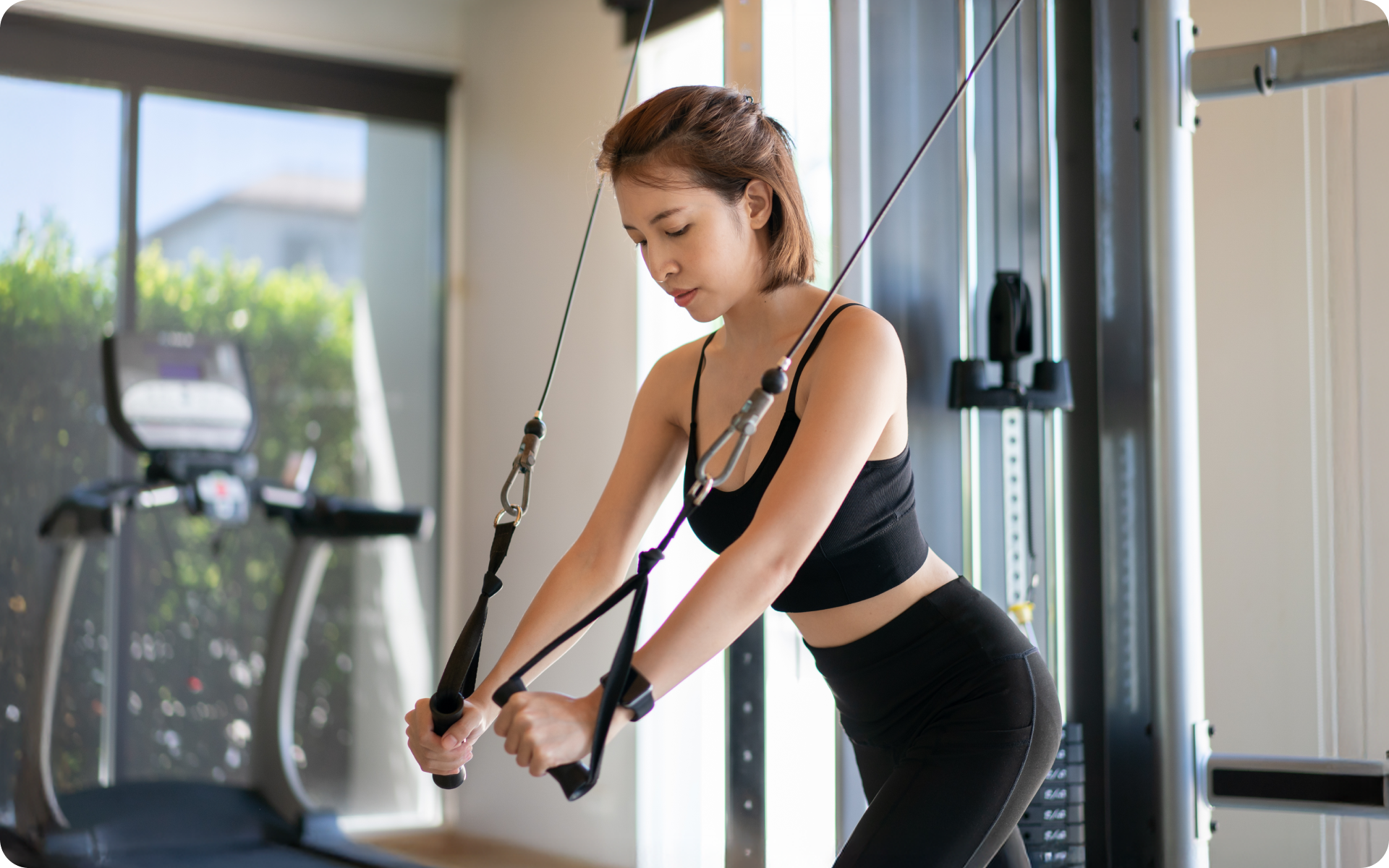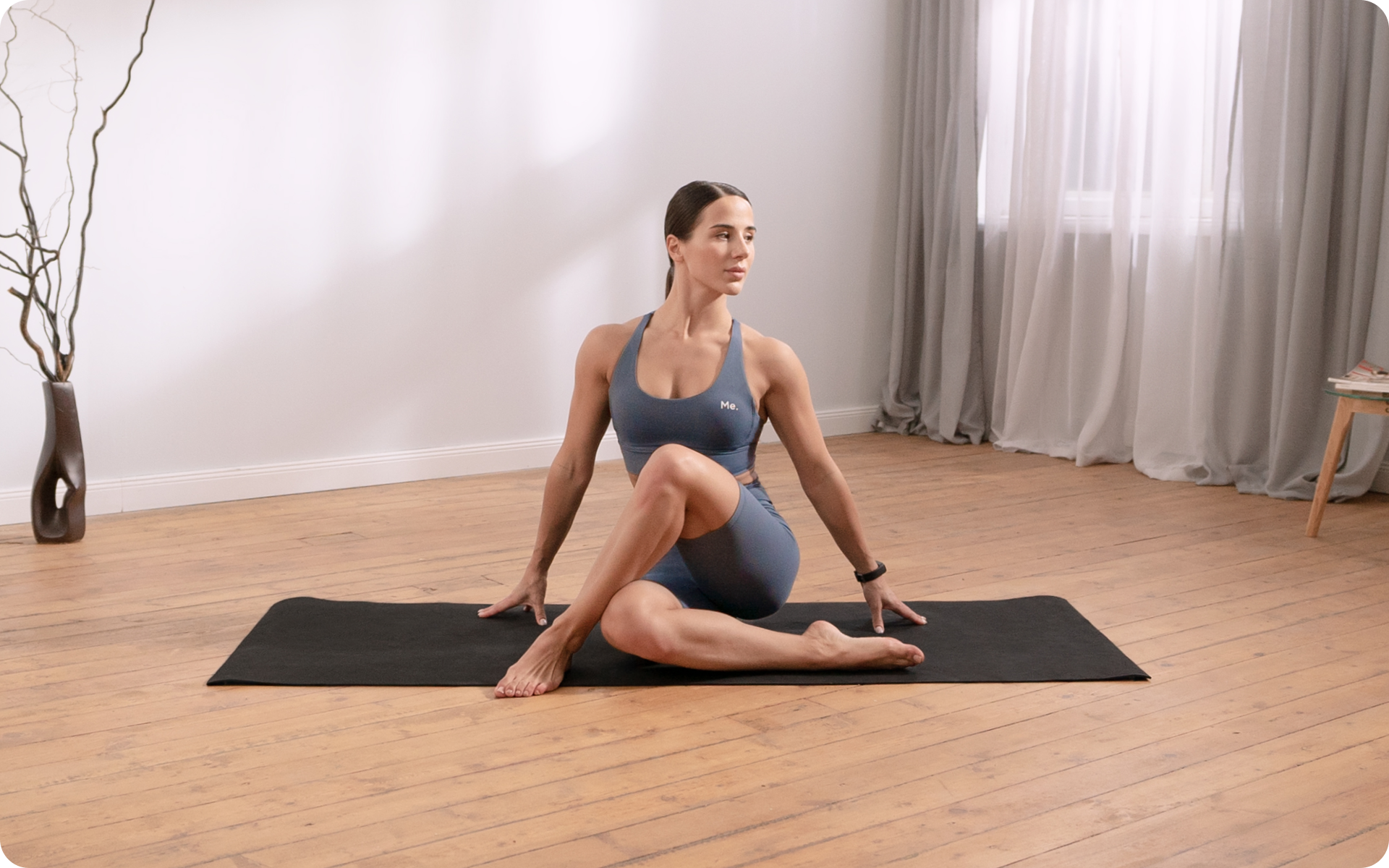Postpartum can be a tough period, even for the strongest of women. From sleepless nights to hormonal changes and the constant care a newborn requires, there’s a lot to deal with. And of course, then comes the pressure to bounce back to your pre-baby body.
But you’re here because you’ve decided that it’s time to reclaim your fitness, at your own pace, in your own way.
This guide is designed to support you on your journey back to fitness.
It covers the unique needs of every type of mom, whether you had a natural birth or a C-section, you’re breastfeeding, or you’re juggling multiple children. Everyone is different, and we believe every mom deserves a tailored approach to postpartum fitness.
How Soon Should You Exercise After Giving Birth?
If you’ve had an uncomplicated vaginal delivery, you can start exercising soon after giving birth. Uncomplicated generally means minimal perineal tears, no medical complications, and normal blood loss after delivery. A general rule is to wait 2 weeks to allow your body time to rest before you start things back up. If you’ve had a c-section, complications with delivery, or medical complications of pregnancy, it is advisable to wait around six weeks after delivery before you return to pre-pregnancy exercise levels (1) (3). In any case, it’s best to consult your doctor.
The reason for this possible waiting period is simple: your body needs time to heal. Childbirth, whether vaginal or cesarean, places a significant amount of strain on your body, so it’s best not to jump back into exercise too quickly. Remember the mantra: slow and steady wins the race. This is particularly true when it comes to postpartum fitness.
Of course, every woman is unique, and how quickly you can return to exercise is dependent on a variety of factors, including your overall health, your fitness level before and during pregnancy, and the particular demands of your childbirth experience.
For example, if you had a straightforward vaginal delivery and were active throughout your pregnancy, you may feel you’re ready to start gentle exercises sooner than someone who had a C-section or experienced complications during delivery (1).
At the same time, if you were on bed rest or had a physically demanding labor, you may need more time to recover before you slowly reintroduce physical activity.
It’s also important to remember that starting an exercise routine doesn’t mean you need to hit the gym for an hour every day. Even gentle walks with the stroller can be a great way of starting to become active again.
In our article on running postpartum, we share a guide to getting you back on track for running, but the principles can be applied to any form of exercise.
If you struggle to even flirt with the idea of giving up your favorite foods or working out till your legs give way – BetterMe app is here to breathe a fresh perspective into the way you view the weight loss process! Check out the app and experience the fun side of fitness and dieting with BetterMe!
What Exercises Can I Do Postpartum?
After consulting your doctor and when you feel ready to perform light physical activity, you can perform postpartum exercises. These are specifically designed to help your body recover from childbirth and slowly regain strength and fitness.
They are primarily focused on strengthening the core, improving flexibility, and enhancing overall stamina. They can easily be incorporated into your postpartum workout plan at home and are adaptable to accommodate your needs if you’re breastfeeding.
Here are some exercises that can be included in your 12-week or 30-day postpartum workout plan:
Kegel Exercises
Kegel exercises are an essential part of any postpartum workout plan. They help strengthen the pelvic floor muscles, which become stretched and weakened during childbirth, whether through vaginal delivery or c-section.
- Identify your pelvic floor muscles
- Tighten (contract) your pelvic floor muscles
- Hold the contraction for five seconds, then relax for five seconds
- Increase your hold to 10 seconds at a time
- Aim for a minimum of three sets of 10 repetitions a day
Pelvic Tilts
Pelvic tilts are excellent for strengthening your abdominal muscles and can be incorporated into a postpartum workout plan while you’re breastfeeding. They’re also beneficial for reducing postpartum back pain.
- Lie down on your back, bend your knees, and keep your feet flat on the floor
- Flatten your back against the floor by tightening your abdominal muscles and bending your pelvis upward slightly
- Hold for up to 10 seconds
- Repeat 10-20 times, in sets of 5
Walking
Walking is a simple and effective way of starting to get active, particularly during the first few weeks postpartum. It can easily be integrated into your postpartum workout plan week by week.
- Start with a slow, short walk
- Gradually increase your pace and distance over time
- Maintain good posture and remain hydrated
- Repeat daily and gradually increase as per your comfort level
Gentle Yoga
Yoga is an excellent way of regaining flexibility and balance postpartum. It can be a part of your postpartum workout plan at the gym, or it can be done at home with online classes.
Rather than heading straight into core exercises postpartum, you should consider starting with gentle yoga exercises such as cat-cow and child’s pose.
- Start with a gentle yoga class or video
- Follow the instructor’s guidance for each pose
- Focus on your breathing and the movement of your body
- Practice regularly, at least twice a week
Read more: Mom Exercise: Benefits, How-To and Everything Else You Need to Know
Gentle Pilates
An after-pregnancy stomach is a real issue for many women. Gentle Pilates exercises are an excellent way to strengthen and tone the core muscles that are severely stretched during pregnancy.
These exercises often involve the conditioning of the entire body, but they focus on the abdominal muscles in particular. Before adding this to a postpartum workout plan after a C-section, make sure you’ve received clearance from your doctor.
- Start with a gentle Pilates class or video
- Focus on proper form and control of your movements
- Avoid any exercises that cause you discomfort or pain
- Practice regularly, at least twice a week
Low-Impact Cardio
Low-impact cardio activities such as swimming, cycling, or using a stationary bike can be incorporated into your postpartum workout plan to help increase endurance and overall fitness. They’re also gentle on the joints, making them ideal for postpartum recovery.
- Choose an activity you enjoy and that feels comfortable for your body
- Start slowly and gradually increase the intensity over time
- Aim for a minimum of 30 minutes of activity, three times per week
- Listen to your body and rest when you need to
Which Exercise Is Best for Postpartum Belly?
Any exercise that increases your heart rate and engages your abdominal muscles can help with postpartum belly.
However, the length of time since delivery is important. What we call a postpartum belly may not actually be fat and can simply be the abdominal muscles and skin that have become stretched during pregnancy.
In this case, exercises such as Kegels, pelvic tilts, gentle yoga, and Pilates can help strengthen and tone these muscles back to their pre-pregnancy state.
If you’re further along postpartum or have additional excess fat in your belly area, low-impact cardio activities can help burn calories and reduce fat.
Whether you’re a workout beast or just a beginner making your first foray into the world of fitness and dieting – BetterMe has a lot to offer to both newbies and experts! Install the app and experience the versatility first-hand!
What Stretches Should I Do at 2 Weeks Postpartum?
At two weeks postpartum, your body is still in the early stages of recovery, and your exercise routine should reflect that. The American College of Obstetricians and Gynecologists (ACOG) emphasizes the importance of light exercise and activity in the weeks immediately following childbirth (1).
Gentle, restorative stretches can help improve flexibility, enhance circulation, and foster overall well-being (2). These stretches are low-impact and are entirely suitable for this stage of postpartum recovery.
Below are some postnatal yoga stretches that can be incorporated into your postpartum workout plan 2 weeks after delivery:
1. Child’s Pose (Balasana)
This is a basic and restorative pose that stretches the back, hips, and thighs. It’s also an excellent opportunity for deep breathing and relaxation. Depending on how you feel, you can hold this pose for 30 seconds to a few minutes.
- Start on your hands and knees with your arms stretched out in front of you
- Slowly lower your hips toward your heels and rest your forehead on the floor
- Keep your arms stretched out in front of you or alongside your body
- Hold for as long as comfortable, then slowly come back up to the starting position
2. Cat-Cow (Marjaryasana/Bitilasana)
This is a gentle pose that focuses on stretching the spine and abdomen while opening up the chest and shoulders. You can make your movements as slow or as fast as you want, depending on how your body feels.
- Start on your hands and knees with your wrists directly under your shoulders and knees under your hips
- As you inhale, arch your back and look up toward the ceiling (cow pose)
- As you exhale, round out your spine and tuck in your tailbone (cat pose)
- Continue this movement for a few breaths
3. Standing Forward Bend (Uttanasana)
This pose stretches the hamstrings and hips while promoting relaxation and calming the mind.
- Stand with your feet hip-width apart, then slowly bend forward from your hips
- If possible, place your hands on the floor beside your feet, or use blocks for support if required
- Relax your head and neck and allow your upper body to hang down
- Hold for 30 seconds to a minute, then slowly come back up to a standing position
4. Side-Lying Stretch
This is a gentle stretch that targets the chest, shoulders, and obliques.
- Start by lying on your side with your knees bent
- Place your top hand on the floor in front of you for support
- Slowly extend your bottom arm out to the side and gently rotate your upper body toward the floor
- Hold for 30 seconds, then switch to the other side
5. Neck and Shoulder Rolls
These simple stretches can help alleviate tension in the neck and shoulders, which are often sore from breastfeeding and carrying your baby.
- Sit comfortably with your feet flat on the floor
- Slowly roll your shoulders forward, up, back, and down in a circular motion
- Repeat 5-10 times before reversing the direction
- Slowly tilt your head to one side and hold for a few seconds before returning to the center
- Repeat on the other side
6. Side Stretch
This stretch targets the oblique muscles and can also provide relief for tight lower-back muscles.
- Start by sitting cross-legged on the floor or a mat
- Extend one arm up toward the ceiling, then slowly bend to one side, reaching your hand over your head
- Keep your hips anchored to the floor and avoid leaning too far forward or backward
- Hold for a few breaths, then switch sides
- You can also incorporate a gentle twist in this stretch by turning your upper body toward the ceiling while you reach overhead with your arm
- Remember to breathe deeply and listen to your body as you hold each stretch
Read more: 5 At Home Workouts for Moms, With and Without Weights
FAQs
How can I make my tummy flat after delivery?
To flatten your tummy after delivery, you should engage in exercises that target your abdominal muscles, such as gentle Pilates or yoga, in combination with low-impact cardio to help with fat burning. In addition, staying hydrated and maintaining a healthy diet that is rich in fruits, vegetables, lean proteins, and complex carbohydrates can help with weight loss. However your healing process goes, remember to honor your postpartum body and give yourself grace.
What exercises should you not do postpartum?
You should avoid intense abdominal workouts such as sit-ups, crunches, or planks immediately after delivery as they can place undue stress on your pelvic floor and abdominal muscles. High-intensity workouts or heavy lifting should also be avoided until your doctor gives you the all clear for such activities. You must always remember to prioritize rest and recovery during the early postpartum period.
Does exercise affect milk supply?
Moderate exercise does not generally affect milk supply. However, intense workouts can cause dehydration, potentially impacting milk production. Staying hydrated and eating a balanced diet can help maintain a healthy milk supply. If you’re breastfeeding, make sure that you wear a supportive sports bra during exercise to prevent discomfort.
How can I lose weight after pregnancy?
Losing weight after pregnancy is a natural process that occurs with the loss of the placenta and amniotic fluid. From postpartum and beyond, maintaining a healthy weight involves a combination of regular exercise and a balanced diet. During the early postpartum period, when you’re ready to get back to exercise, you should start with light, low-impact exercises such as walking, gentle yoga, or pelvic floor exercises, and gradually increase the intensity as your body recovers. Eating a diet low in ultra-processed foods and high in fruits, vegetables, lean proteins, healthy fats, and whole grains can also help.
The Bottom Line
Incorporating gentle exercises, stretches, and low-impact cardio into your postpartum workout plan can help with your physical recovery and also improve your overall well-being. It’s important to remember to always listen to your body and consult your doctor before you start any new exercise routine, particularly after having given birth.
The best postpartum workout plan is gentle (to avoid injury), customized (because everybody is different), and focused on overall well-being rather than just weight loss. Remember to prioritize rest, listen to your body, and consult your doctor before you start any exercise routine after giving birth.
DISCLAIMER:
This article is intended for general informational purposes only and does not serve to address individual circumstances. It is not a substitute for professional advice or help and should not be relied on for making any kind of decision-making. Any action taken as a direct or indirect result of the information in this article is entirely at your own risk and is your sole responsibility.
BetterMe, its content staff, and its medical advisors accept no responsibility for inaccuracies, errors, misstatements, inconsistencies, or omissions and specifically disclaim any liability, loss or risk, personal, professional or otherwise, which may be incurred as a consequence, directly or indirectly, of the use and/or application of any content.
You should always seek the advice of your physician or other qualified health provider with any questions you may have regarding a medical condition or your specific situation. Never disregard professional medical advice or delay seeking it because of BetterMe content. If you suspect or think you may have a medical emergency, call your doctor.
SOURCES:
- Exercise After Pregnancy (2022,acog.org)
- Stretching: 9 Benefits (2019,maine.gov)
- When and how to exercise after a c-section (2021,tommys .org)












